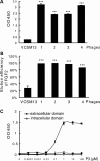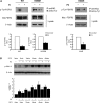A novel FGFR3-binding peptide inhibits FGFR3 signaling and reverses the lethal phenotype of mice mimicking human thanatophoric dysplasia
- PMID: 23014564
- PMCID: PMC3657479
- DOI: 10.1093/hmg/dds390
A novel FGFR3-binding peptide inhibits FGFR3 signaling and reverses the lethal phenotype of mice mimicking human thanatophoric dysplasia
Abstract
Gain-of-function mutations in fibroblast growth factor receptor-3 (FGFR3) lead to several types of human skeletal dysplasia syndromes including achondroplasia, hypochondroplasia and thanatophoric dysplasia (TD). Currently, there are no effective treatments for these skeletal dysplasia diseases. In this study, we screened, using FGFR3 as a bait, a random 12-peptide phage library and obtained 23 positive clones that share identical amino acid sequences (VSPPLTLGQLLS), named as peptide P3. This peptide had high binding specificity to the extracellular domain of FGFR3. P3 inhibited tyrosine kinase activity of FGFR3 and its typical downstream molecules, extracellular signal-regulated kinase/mitogen-activated protein kinase. P3 also promoted proliferation and chondrogenic differentiation of cultured ATDC5 chondrogenic cells. In addition, P3 alleviated the bone growth retardation in bone rudiments from mice mimicking human thanatophoric dysplasia type II (TDII). Finally, P3 reversed the neonatal lethality of TDII mice. Thus, this study identifies a novel inhibitory peptide for FGFR3 signaling, which may serve as a potential therapeutic agent for the treatment of FGFR3-related skeletal dysplasia.
Figures






Similar articles
-
HDAC6 deficiency or inhibition blocks FGFR3 accumulation and improves bone growth in a model of achondroplasia.Hum Mol Genet. 2016 Oct 1;25(19):4227-4243. doi: 10.1093/hmg/ddw255. Epub 2016 Aug 9. Hum Mol Genet. 2016. PMID: 27506979
-
Nordihydroguaiaretic acid inhibits an activated fibroblast growth factor receptor 3 mutant and blocks downstream signaling in multiple myeloma cells.Cancer Res. 2008 Sep 15;68(18):7362-70. doi: 10.1158/0008-5472.CAN-08-0575. Cancer Res. 2008. PMID: 18794123 Free PMC article.
-
Intermittent PTH (1-34) injection rescues the retarded skeletal development and postnatal lethality of mice mimicking human achondroplasia and thanatophoric dysplasia.Hum Mol Genet. 2012 Sep 15;21(18):3941-55. doi: 10.1093/hmg/dds181. Epub 2012 May 24. Hum Mol Genet. 2012. PMID: 22634226
-
Sixteen years and counting: the current understanding of fibroblast growth factor receptor 3 (FGFR3) signaling in skeletal dysplasias.Hum Mutat. 2012 Jan;33(1):29-41. doi: 10.1002/humu.21636. Epub 2011 Nov 16. Hum Mutat. 2012. PMID: 22045636 Free PMC article. Review.
-
Review of the recently defined molecular mechanisms underlying thanatophoric dysplasia and their potential therapeutic implications for achondroplasia.Am J Med Genet A. 2010 Jan;152A(1):245-55. doi: 10.1002/ajmg.a.33188. Am J Med Genet A. 2010. PMID: 20034074 Review.
Cited by
-
Advances in Skeletal Dysplasia Genetics.Annu Rev Genomics Hum Genet. 2015;16:199-227. doi: 10.1146/annurev-genom-090314-045904. Epub 2015 Apr 22. Annu Rev Genomics Hum Genet. 2015. PMID: 25939055 Free PMC article. Review.
-
FGFR3/fibroblast growth factor receptor 3 inhibits autophagy through decreasing the ATG12-ATG5 conjugate, leading to the delay of cartilage development in achondroplasia.Autophagy. 2015 Nov 2;11(11):1998-2013. doi: 10.1080/15548627.2015.1091551. Autophagy. 2015. PMID: 26491898 Free PMC article.
-
Knock-in human FGFR3 achondroplasia mutation as a mouse model for human skeletal dysplasia.Sci Rep. 2017 Feb 23;7:43220. doi: 10.1038/srep43220. Sci Rep. 2017. PMID: 28230213 Free PMC article.
-
Achondroplasia: a comprehensive clinical review.Orphanet J Rare Dis. 2019 Jan 3;14(1):1. doi: 10.1186/s13023-018-0972-6. Orphanet J Rare Dis. 2019. PMID: 30606190 Free PMC article. Review.
-
Advances in the mechanism and therapies of achondroplasia.Genes Dis. 2024 Sep 24;12(4):101436. doi: 10.1016/j.gendis.2024.101436. eCollection 2025 Jul. Genes Dis. 2024. PMID: 40256430 Free PMC article. Review.
References
-
- Xian C.J. Roles of epidermal growth factor family in the regulation of postnatal somatic growth. Endocr. Rev. 2007;28:284–296. - PubMed
-
- Shiang R., Thompson L.M., Zhu Y.Z., Church D.M., Fielder T.J., Bocian M., Winokur S.T., Wasmuth J.J. Mutations in the transmembrane domain of FGFR3 cause the most common genetic form of dwarfism, achondroplasia. Cell. 1994;78:335–342. - PubMed
-
- Horton W.A. Fibroblast growth factor receptor 3 and the human chondrodysplasias. Curr. Opin. Pediatr. 1997;9:437–442. - PubMed
-
- Bonaventure J., Rousseau F., Legeai-Mallet L., Le Merrer M., Munnich A., Maroteaux P. Common mutations in the fibroblast growth factor receptor 3 (FGFR 3) gene account for achondroplasia, hypochondroplasia, and thanatophoric dwarfism. Am. J. Med. Genet. 1996;63:148–154. - PubMed
-
- Rousseau F., el Ghouzzi V., Delezoide A.L., Legeai-Mallet L., Le Merrer M., Munnich A., Bonaventure J. Missense FGFR3 mutations create cysteine residues in thanatophoric dwarfism type I (TD1) Hum. Mol. Genet. 1996;5:509–512. - PubMed
Publication types
MeSH terms
Substances
Supplementary concepts
Grants and funding
LinkOut - more resources
Full Text Sources
Other Literature Sources
Molecular Biology Databases

